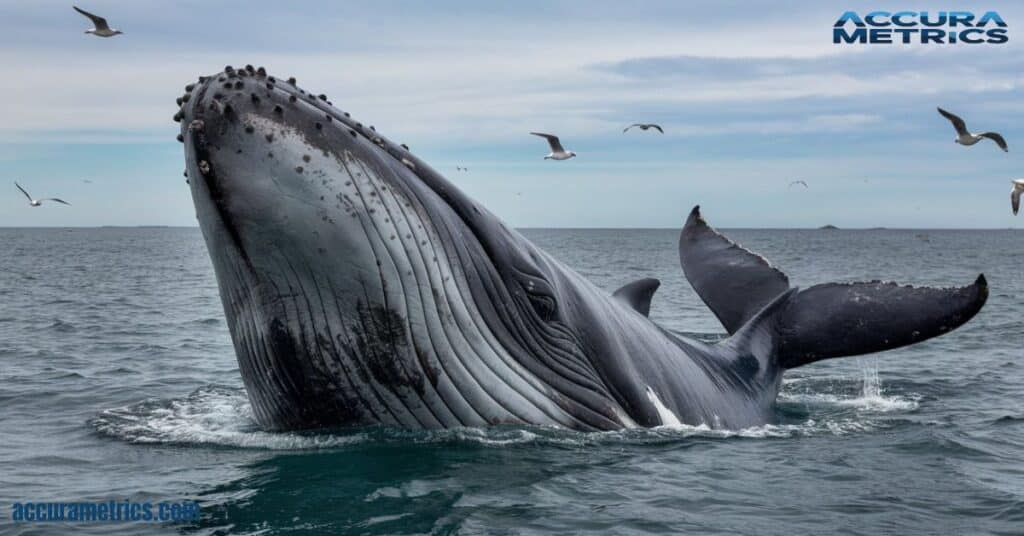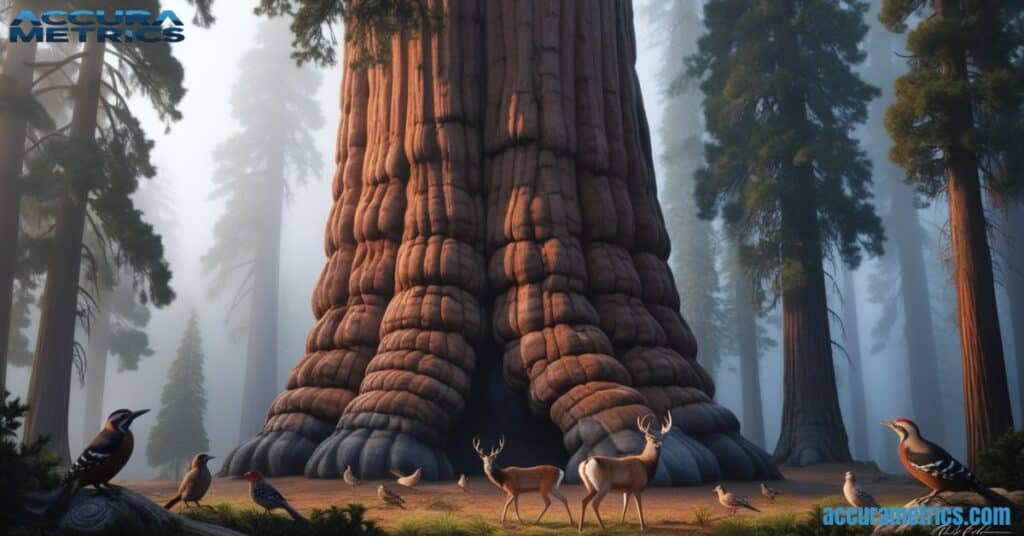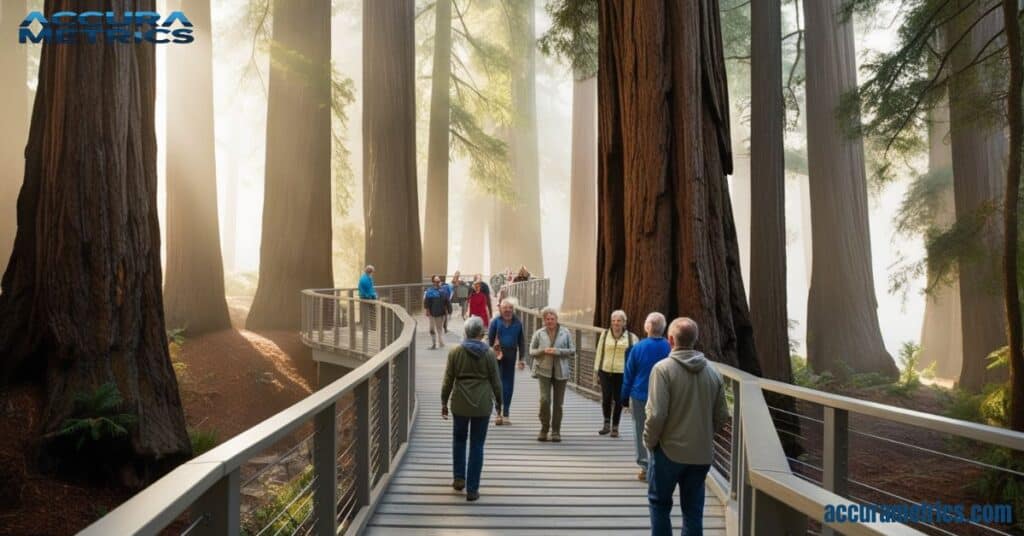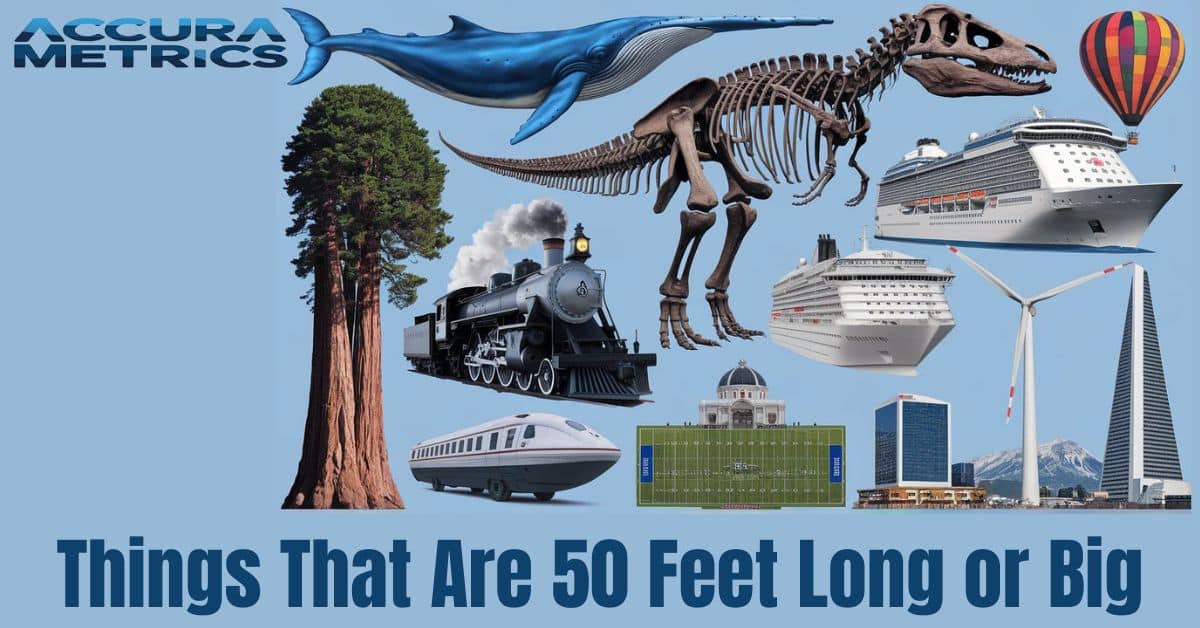Have you ever wondered just how big 50 feet really is? It’s a measurement that pops up more often than you might think, from the depths of the ocean to the heights of Hollywood. In this deep dive, we’ll explore ten fascinating things that clock in at around 50 feet, giving you a fresh perspective on this intriguing dimension.
Buckle up as we embark on a journey that’ll have you seeing the world through a whole new lens!
Understanding 50 Feet in Everyday Terms
Before we jump into our list, let’s get a grip on what 50 feet means in terms we can all relate to. For instance, picture this: you’re taking a stroll down the sidewalk. At an average walking pace, you’d cover 50 feet in about 10-15 seconds. Additionally, that’s roughly the length of a semi-trailer truck or the width of a small parking lot.
Visually, 50 feet is about as long as five cars parked bumper to bumper. It’s a distance that’s substantial enough to make an impact, yet not so vast that it’s hard to comprehend. Moreover, in terms of height, imagine standing on the roof of a five-story building – that’s your 50-foot vantage point right there.
Now that we’ve got our bearings, let’s dive into the diverse world of 50-foot wonders!
Natural Wonders at 50 Feet
Whale Shark: The Ocean’s Gentle Giant

When it comes to fish, the whale shark reigns supreme in size. These magnificent creatures can grow up to 50 feet in length, making them the largest fish in the sea. Despite their imposing size, whale sharks are known for their gentle nature.
In addition, they feed primarily on plankton and small fish, highlighting their peaceful existence in the ocean.
Fun Fact: A whale shark’s mouth can be up to 5 feet wide – large enough to fit a human inside, though you’d never find one trying to swallow you whole!
Here’s a quick comparison of the whale shark to other large shark species:
| Species | Maximum Length |
| Whale Shark | 50 feet |
| Great White Shark | 20 feet |
| Tiger Shark | 16 feet |
| Hammerhead Shark | 20 feet |
The whale shark’s massive size allows it to store energy efficiently, enabling it to undertake long migrations across ocean basins. These gentle giants play a crucial role in marine ecosystems, helping to regulate the populations of the tiny organisms they feed on.
Humpback Whale: A Melodious Marine Mammoth

Another ocean dweller that can reach the 50-foot mark is the humpback whale. These majestic creatures are known not just for their size, but for their haunting songs that can travel for miles underwater.
The humpback whale’s impressive length plays a significant role in its ability to produce these complex vocalizations. Their large bodies act as resonance chambers, allowing them to create a wide range of sounds that can last for up to 20 minutes.
Did you know? Humpback whales can weigh up to 40 tons – that’s about the weight of 5-6 adult elephants!
Their size also impacts their incredible migration patterns. Humpbacks are known to travel up to 16,000 miles annually, making them one of the farthest-migrating mammals in the world. This 50-foot frame allows them to store enough energy to make these epic journeys while fasting for months at a time.
Explore 10 things around 50 feet long or tall, like 50 foot giant sequoias

While not all giant sequoias reach their full potential height of over 300 feet, many of these incredible trees hit the 50-foot mark within their first century of life. These natural skyscrapers are a testament to the power and longevity of nature.
- At 50 feet tall, a giant sequoia is already supporting a diverse ecosystem
- Birds, insects, and small mammals make their homes in these towering trees
- The tree’s thick bark, which can be up to 3 feet thick, provides excellent insulation and fire resistance
A 50-foot sequoia is just getting started on its journey to the sky. These trees can live for over 3,000 years, continually growing throughout their lifespan. The next time you’re near a five-story building, imagine that same height as a living, growing organism – that’s the power of the giant sequoia.
Read more 12 Everyday Items That Are About 5 Inches Long
Human-Made Marvels Measuring 50 Feet
Semi-trailer: The Backbone of Commerce

When you’re cruising down the highway, you’ve probably noticed those long trucks carrying everything from food to furniture. Most semi-trailers are around 48 feet in length nearest to 50 feet, just shy of our 50-foot benchmark.
This standard size has become the backbone of the trucking industry, optimizing cargo space while still allowing for maneuverability on roads and highways.
The 48 to 53-foot range for semi-trailers didn’t happen by accident. It’s the result of years of engineering and logistics optimization. Here’s why this length is so crucial:
- Maximizes cargo capacity within legal limits
- Allows for efficient loading and unloading at standardized docks
- Provides a balance between carrying capacity and fuel efficiency
- Ensures compatibility with various truck models and road regulations
Moving these huge things needs skill and carefulness. Truck drivers undergo extensive training to handle the challenges of piloting a vehicle that’s essentially a building on wheels. Next time you see a semi on the road, give a nod to the engineering and skill that goes into moving goods across the country in these 50-foot marvels.
Redwood Tree Canopy Walkway: A 50 Feet Stroll in the Treetops

Imagine walking among the giants of the forest, not on the ground, but 50 feet up in the air. That’s exactly what you can do on a redwood tree canopy walkway. These engineering marvels, often found in botanical gardens and nature parks, offer a unique perspective on one of nature’s most impressive ecosystems.
A typical redwood canopy walkway stretches about 50 feet long, suspended between massive trees. This length provides:
- Enough distance for visitors to feel immersed in the canopy
- A stable structure that can withstand wind and tree movement
- Multiple viewing points to observe different aspects of forest life
Key Features of a 50 Feet Canopy Walkway:
- Sturdy construction, often using steel cables and platforms
- Safety railings and non-slip surfaces for visitor security
- Minimal impact on the trees and surrounding ecosystem
- Educational signage about canopy flora and fauna
Walking these 50-foot spans provides visitors with a squirrel’s-eye view of the forest. From this unique vantage point, you can therefore observe:
- Epiphytes (plants growing on other plants) that rarely touch the forest floor
- Canopy-dwelling animals like birds, insects, and sometimes small mammals
- The intricate branching structure of ancient redwoods
- A bird’s-eye view of the forest floor far below
These walkways serve an important role in conservation education. By allowing people to experience the canopy firsthand, they foster a deeper appreciation for these complex ecosystems. The 50 feet length of these walkways is carefully chosen to provide an immersive experience while minimizing impact on the trees.
Next time you visit a redwood forest, look for these 50 feet pathways in the sky. They offer a unique perspective on one of nature’s most majestic environments and a chance to walk among the treetops, if only for a short while.
Read More 9 Common Things That Are 5 Centimeters Long
Five-story Building: Vertical 50 Feet

When we think of 50 feet vertically, a five-story building often comes to mind. Each story typically measures about 10 feet, which adds up to a total of 50 feet. Consequently, these mid-rise structures are common in urban areas, balancing efficient land use while maintaining a human scale in city neighborhoods.
Buildings of this height are versatile and, moreover, can serve various purposes:
- Residential apartments or condominiums
- Mixed-use developments with retail on lower floors and offices or residences above
- Small hotels or boutique accommodations
- Educational facilities like schools or libraries
Energy efficiency is a key consideration in five-story buildings. At this height, they can often rely on natural ventilation and daylighting strategies, reducing the need for extensive mechanical systems.
Many modern five-story structures incorporate green design elements like rooftop gardens or solar panels, making the most of their 50 feet elevation.
Sports and Entertainment at 50 Feet
Half the Distance Between Baseball Bases

Baseball fans, did you know that the distance between bases is 90 feet? That means the halfway point between bases is right at our magic number of 45 feet. This measurement has been a standard since the 1880s and plays a crucial role in the dynamics of the game.
The 90-foot baseline (and thus, the 45-foot halfway point) creates a delicate balance:
- It’s long enough to challenge the throwing arm of infielders
- Short enough to give fast runners a chance to beat out a throw
- Creates exciting plays at first base, often decided by milliseconds
Some of baseball’s most thrilling moments happen within this 50 feet span. Think about a runner trying to steal second base or a batter legging out an infield single. These plays often come down to split-second decisions and lightning-fast reflexes, all within the space of 50 feet.
The Hollywood Sign: A Towering Symbol of Tinseltown

When you think of Hollywood, one image likely comes to mind: the iconic Hollywood Sign. Standing at approximately 49 feet tall, these massive letters have become a symbol of the entertainment industry and the dreams of aspiring stars.
Originally erected in 1923 as “Hollywoodland” to advertise a real estate development, the sign has undergone several restorations over the years. Today, it stands as a protected landmark, visible for miles across Los Angeles.
Quick Facts about the Hollywood Sign:
- Each letter is 45 feet tall and ranges from 31 to 39 feet wide
- The total length of the sign is 350 feet
- It’s made of white-painted sheet metal
- The sign is illuminated at night by 20 spotlights
The Hollywood Sign’s imposing height and prominent location have consequently made it a cultural icon, featured in countless films, TV shows, and photographs. Moreover, its 50-foot stature serves as both a beacon for dreamers and a reminder of the larger-than-life nature of the entertainment industry.
Tools and Technology at the 50 Feet Mark
Industrial Tape Measure: Precision at Length

The evolution of measuring technology has been fascinating:
- Ancient civilizations used body parts (like feet and hands) for measurements
- Thus, standardized measuring sticks and chains were developed for greater consistency.
- Spring-loaded retractable tape measures, which were invented in the 1800s, became essential tools; therefore, they significantly improved measurement efficiency.
- Modern laser measuring devices can now measure distances instantly and, furthermore, accurately.
Despite technological advances, the 50-foot tape measure remains a staple in many industries; furthermore, its tactile nature and reliability make it an indispensable tool for professionals who need quick and accurate measurements in the field.
Wind Turbine Blades: Harnessing Energy at Scale

While not all wind turbine blades are precisely 50 feet long, many, however, fall within this range, particularly for smaller, land-based turbines. Moreover, the length of these blades plays a crucial role in the turbine’s power generation capacity.
How blade length affects power generation:
- Longer blades can capture more wind energy
- Each doubling of blade length quadruples the potential power output
- 50-foot blades are often used in turbines generating 100-400 kilowatts
Transporting and installing these massive blades presents unique challenges. For instance, special trucks with extendable trailers are often required to move the blades from manufacturing facilities to wind farm sites. Additionally, once on site, enormous cranes are used to lift and attach the blades to the turbine tower.
As we push for more renewable energy sources, wind turbines – and their impressive 50-foot blades – are becoming an increasingly common sight on our horizons.
Unexpected 50 Feet, 5 Full-Grown Alligators

Imagine lining up five alligators end to end – you’d have about 50 feet of prehistoric-looking power! Although the average adult American alligator is around 10 feet long, some can grow even larger. Consequently, this impressive length highlights their formidable size.
Alligator size can vary significantly based on factors like:
- Gender (males are typically larger)
- Age (they continue growing throughout their lives)
- Habitat conditions
- Food availability
Conservation efforts have helped alligator populations recover from near-extinction in many areas. Consequently, these 50 feet of combined alligator length represent not just an impressive measurement but also a success story in wildlife management and ecosystem preservation.
For more insights checkout our article 9 Things That Are 80 Feet (ft) Long
The Width of a Regulation Basketball Court

Basketball fans might be surprised to learn that the width of a regulation NBA court is precisely 50 feet. Indeed, this dimension plays a crucial role in game strategy and player positioning.Consequently, it influences how teams execute plays and utilize space on the court.
How the 50-foot width influences gameplay:
- Determines the “short corner” three-point shot distance
- Affects defensive strategies and zone coverages
- Influences fast break and transition play tactics
While the NBA uses this 50-foot width, other leagues and levels of play may vary slightly. For example, FIBA (International Basketball Federation) courts are slightly narrower at 49 feet wide. Consequently, these variations can affect the dynamics and strategy of the game across different levels.
Conclusion
From the depths of the ocean to the heights of Hollywood, the 50-foot dimension shapes our world in surprising ways. Moreover, whether it’s the graceful glide of a whale shark, the precision of a bowling lane, or the iconic stature of the Hollywood Sign, this measurement connects diverse aspects of nature, technology, and human achievement.
The next time you encounter something around 50 feet in length or height, take a moment to appreciate its scale. Additionally, you might find yourself seeing the world from a whole new perspective – one that’s about 50 feet wide.
Interactive Quiz: Can You Guess What Else is 50 Feet?
- What famous monument is about 50 feet tall at its highest point? a) The Statue of Liberty b) The Eiffel Tower c) The Sphinx d) The Lincoln Memorial
- Which animal, now extinct, was approximately 50 feet long? a) Tyrannosaurus Rex b) Megalodon c) Woolly Mammoth d) Pteranodon
- In the world of technology, what common device often comes in 50-foot lengths? a) USB cable b) Ethernet cable c) Phone charger d) HDMI cable
(Answers: 1. c) The Sphinx, 2. b) Megalodon, 3. b) Ethernet cable)As we wrap up our exploration of 50-foot wonders, remember that this dimension is all around us, from two and a half shipping containers lined up to the length of five alligators sunbathing on a riverbank. Keep your eyes open, and you’ll start seeing the world in intervals of 50 feet.
Read More Amazing 10 Things That Are 100 Feet Long

My name is Linda, and I am an experienced blogger with a passion for precision and craftsmanship. With years of expertise, I contribute to Accura Matrics, bringing a wealth of knowledge and a keen eye for detail. My insightful articles and expert tips are designed to help readers achieve excellence in their measurements and dimensions projects, offering valuable guidance in the pursuit of accurate and thoughtful design.

